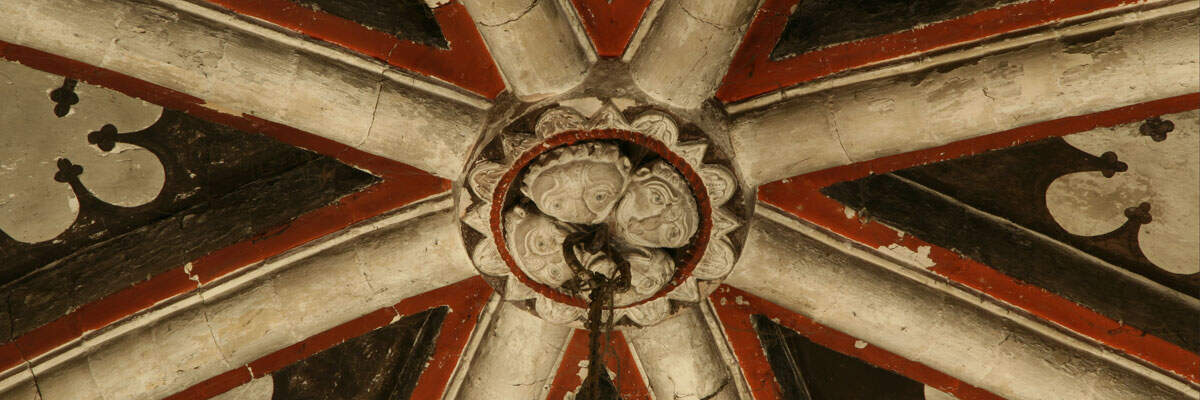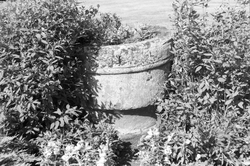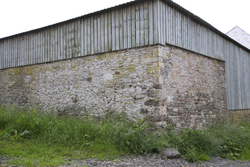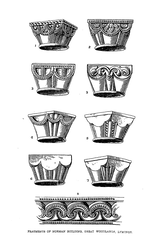
The Corpus of ROMANESQUE SCULPTURE in Britain & Ireland

Farm building
Farm building
Waterton Hall is a large stone farmhouse with several outbuildings dating to the 18th c. In the front garden there is a Romanesque font that is being used as a planter.
Farm building
The carved panel is built into an exterior wall of a post-medieval farm building, the farm house next to it thought to be 18thc (but could be early 19thc). Knowetownhead is located near Hassendean Burn, just NW of the site of Hassendean Chapel which was originally located at the juncture of Hassendean Burn and River Teviot. The only other carved stone so far found on the farm buildings is a stone with the date 1828. The last of the lairds of Hassendean seems to be David Scott, who was killed in 1564. Ultimately, the parts were united in the person of Thomas Turnbull, last laird of Minto. In 1673, John Turnbull made a disposition of the land and barony in favour of Walter Scott of Harwood. The land subsequently went through a series of short ownerships but was eventually sold to Gilbert Elliot, who was made first Baron of Minto in 1700. After the church of Hassendean was surpressed in 1690, the parish was split between those of Minto, Roberton and Wilton, the largest part going to Minto. In the land tax rolls for 1803, it states that David Simpson paid £227.8.0 for ‘Know’, but below this, in the same entry, is written that Thomas Gray of Altons paid £214.0.0 for ‘lands now called Knowtownhead’. In the valuation rolls of 1858, ‘Knowtownhead’ is described as ‘a farmhouse with outhouses attached’. At that time, it was inhabited by John Turnbull, though owned by W. J. Scott. John Scott, son of William Scott purchased the estate of Teviotbank about 1804. Teviotbank House was built in 1833, but there had been a previous house called ‘The Knowes’. The farm buildings of Knowetownhead are a short distance from the site of the old church at Hassendean, destroyed by flooding in 1796.
Farm building
This entry is for a site at Lyminge, SE Kent, which was reported by Rev. Robert Jenkins, rector of Lyminge, in 1861. According to Jenkins, the removal of some farm buildings at Great Woodlands, Lyminge adjacent to the boundary wall revealed a quantity of ashlar and worked Romanesque masonry sculpture embedded into quite old mortar. This material apparently included chevron voussoirs, 'embattled' (fret) and billet mouldings together with other typical motifs, and parts of string-courses. There were also fourteen capitals, all of differing design.
With the permission of the farm owner, Miss Tournay, Jenkins (as he reports in his article for Archaeologia Cantiana of 1861) was able to 'take down the portions of the wall in which these stones were found, and to remove any which appeared to me to be of antiquarian value'. Jenkins also mentions similar material elsewhere in the locality which he saw in walls 'at North Lyminge, at Ottinge, at Longage, and in an ancient wall belonging to the Rectory'. Some of the mouldings apparently matched material at these sites. In August 2021 a double capital was found at old Robus, north Lyminge, which could possibly be one of the items which Jenkins saw (see CRSBI report for Old Robus, Lyminge).
Eight capitals (or perhaps seven as two are captioned '3') together with a piece of string-course are illustrated in Jenkins' report. According to Ron Baxter, the capitals are all variants of the scallop and trefoil type; many have beaded decoration, and one has a foliate motif. There is unfortunately no scale on the illustration; one assumes they probably belonged to nook-shafts rather than the main elevation of a church.
The present-day whereabouts of this material is not known, but its preservation in a museum store is technically still within the bounds of possibility; it is hoped that the material illustrated (reproduced here) may help identification one day.


